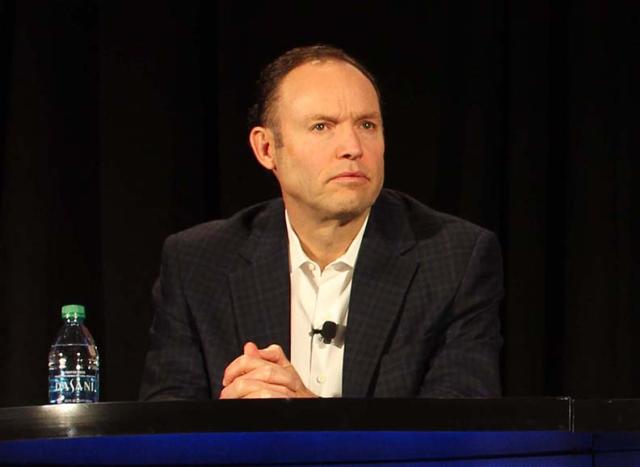
Alan Smith, CEO, Rockcliff Energy at DUG Haynesville in Shreveport, La. (Source: Hart Energy)
SHREVEPORT, La.—With EURs of 2.5 billion cubic feet (Bcf) to more than 3 Bcf per 1,000 feet of lateral, the East Texas Haynesville will compete with the Louisiana play core, according to Alan Smith, president and CEO, Rockcliff Energy LLC.
Smith spoke at Hart Energy’s recently held DUG Haynesville conference and exhibition. The Texas Railroad Commission mostly calls the Haynesville on its side of the border “Lower Bossier,” but it’s the same formation as what’s called Haynesville in Louisiana.
Smith said, “We like to remind people that the deposition of the Haynesville occurred long before the state lines were formed.”
Privately held Rockcliff is producing nearly a half-Bcf a day now from East Texas with about 30 of its wells landed in the Haynesville. It has four rigs at work and an inventory of some 1,400 locations remaining to drill at 800-foot spacing.
“A lot of people think East Texas [Haynesville] is inconsistent—maybe because of the clay content—but, when you map it, there is a significant amount of gas here and it’s thicker than the [Louisiana] core. It makes it a lot easier to come in and wine-rack [well-spacing], which we’re doing,” Smith said.
Even with strict choke management—“we’re not trying to give you any fluff here”—wells are posting IP 30s of 16- to 25 million cubic feet per day from 1.5- and two-section laterals. Rockcliff’s newest fracture-stimulation recipe is 100-ft spacing, 3,500 pounds of proppant per foot, “pretty much slickwater and pretty tight clusters,” Smith said.
“What’s going on [in Louisiana], that production comes toward the west. It comes into East Texas and we think it competes with the core of the Haynesville very well. In fact, some of this is better.”
Most A&D activity left to be done is in the East Texas Haynesville, said Chris Atherton, CEO of asset-marketer EnergyNet LLC. Operators in the Louisiana Haynesville have consolidated into about 10 now, including via the most recent deals. These are BP Plc’s $10.5-billion purchase of BHP Billiton Ltd.’s Haynesville exit, which included Eagle Ford and Permian leasehold, in October and Aethon Energy Management LLC’s $735-million bolt-on of QEP Resources Inc.’s Haynesville exit in January.
On the Louisiana side, “a lot of the acreage is HBP; it’s not expiring,” Atherton said. Acreage transfers are mostly swaps there, with operators trading sections to improve field efficiencies. Instead, “there is a lot more A&D activity in Texas.”
On either side of the border, leasehold is being valued at roughly between $2,500 and $5,000 per acre. While “the Louisiana side has better [valuation] metrics, there is more A&D flow on the East Texas side,” Atherton said. (Editor's Note: The article as originally posted erroneously stated "between $2,500 and $5,000 per flowing Mcf/d." We regret the error.)
Rockcliff has legacy Cotton Valley production in its 275,000-acre position as well. That formation in its area is delineated, but it lacks as much application of horizontal technology as the Haynesville, Smith said.
For now, Rockcliff is continuing to focus on the Haynesville, though, “for the very reason Chris [Atherton] said: A lot of people still don’t put East Texas on their map.
“Not only do we want to see it put on their map, we want to see it get put on there as the [Haynesville] ‘core’ extending into East Texas because we clearly think this is the case based on the results we’re having.”
Rockcliff will drill a few Cotton Valley wells this year. “We have a lot of Cotton Valley inventory, so we’ll get around to that [another time].” It’s all HBP.
Atherton and Geoff Roberts, managing director and head of U.S. A&D for BMO Capital Markets, noted that several Haynesville operators aim to IPO, but that channel remains mostly closed to producers and, particularly, to gas producers.
Roberts said, “We all know gas is out of favor right now…. [On Wall Street], the consensus is there is no real hope for gas prices to recover.”
A liquids component in production helps, but the Haynesville is, “basically, a dry-gas basin and it’s not going to be as exciting as an oil basin for a while,” Roberts said.
Smith said longer-term capital might come in, instead—players “with more of a ‘yield’ mindset.”
Recommended Reading
EIG’s MidOcean Closes Purchase of 20% Stake in Peru LNG
2024-04-23 - MidOcean Energy’s deal for SK Earthon’s Peru LNG follows a March deal to purchase Tokyo Gas’ LNG interests in Australia.
Clean Energy Begins Operations at South Dakota RNG Facility
2024-04-23 - Clean Energy Fuels’ $26 million South Dakota RNG facility will supply fuel to commercial users such as UPS and Amazon.
Texas LNG Export Plant Signs Additional Offtake Deal With EQT
2024-04-23 - Glenfarne Group LLC's proposed Texas LNG export plant in Brownsville has signed an additional tolling agreement with EQT Corp. to provide natural gas liquefaction services of an additional 1.5 mtpa over 20 years.
Deepwater Roundup 2024: Americas
2024-04-23 - The final part of Hart Energy E&P’s Deepwater Roundup focuses on projects coming online in the Americas from 2023 until the end of the decade.
Ohio Utica’s Ascent Resources Credit Rep Rises on Production, Cash Flow
2024-04-23 - Ascent Resources received a positive outlook from Fitch Ratings as the company has grown into Ohio’s No. 1 gas and No. 2 Utica oil producer, according to state data.





